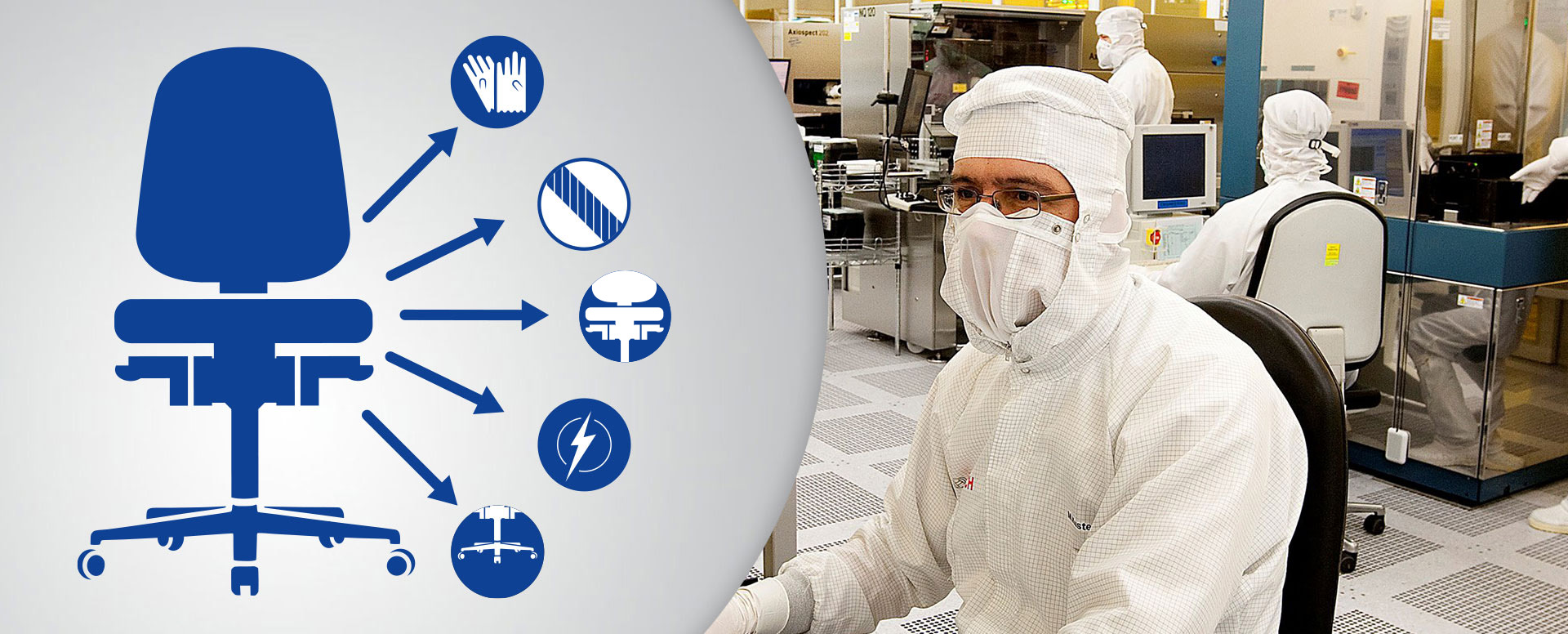
Around the cleanroom – important things to know about working in cleanrooms
Cleanrooms are particularly unique workspaces with special requirements for the furnishings and equipment, the employees who work there and the conduct of all who make use of them. Cleanrooms are necessary for manufacturing and packaging highly engineered or especially sensitive products, and constitute an ideal environment for any kind of research. We will examine the particular features of the cleanroom as a workplace in detail here.An overview of our article
- What is a cleanroom?
- Cleanroom classes
- Cleanrooms vs. ultra-clean rooms
- How cleanrooms work
- The cleanroom workplace
- Room design
- Protective clothing
- Working equipment and furniturel
- Cleanroom chairs
- Conduct in cleanrooms
- Cleaning of cleanrooms
- Excursus: Cleanroom monitoring
- Summary
What is a cleanroom?
The definition of a cleanroom is a room in which the number of airborne particles is kept to a minimum using artificial means. These rooms are used in the semiconductor and chip industry, in the pharmaceutical and food industry, and also in electronic device manufacturing. The small particles in the ambient air that pose no danger to humans can still damage, contaminate or even destroy products from the aforementioned industries.
Cleanroom classes
Different requirements are also placed on cleanrooms depending on the tasks to be carried out in them. These different "cleanroom classes" are defined in the DIN standard EN ISO 14644-1. There are nine of them in total, which are designated sequentially from ISO 1 to ISO 9. A different concentration of particles is given as the maximum limit for each individual class. The permitted size of the particles also varies depending on the class. The food processing industry, for example, frequently uses rooms that have a degree of purity from ISO 6 to ISO 9. The purity in cleanrooms that are used in the semiconductor and chip industry must be significantly higher; in the majority of cases, they correspond to a standard between ISO 1 and ISO 5.
Cleanrooms vs. ultra-clean rooms
Time and again, the term "ultra-clean room" comes up, even though this term does not feature in the standard EN ISO 14644-1. Colloquially, however, it is used to refer to cleanrooms with the highest possible requirements, i.e. the classes ISO 1 to ISO 3.
How cleanrooms work
A cleanroom must have consistent humidity, temperature and pressure conditions. Special ventilation and air conditioning systems are used to guarantee this. The configuration of the cleanroom with regard to the working equipment and furniture must comply with certain requirements, while the work clothing worn by employees that use the cleanroom is also subject to specific regulations.
The cleanroom workplace
Working in cleanrooms can only be a successful endeavour when all employees conform to a strict set of rules. The structural conditions must be suitably adapted to the requirements in the first place, however. This begins with the room design.
Room design
Generally, the lower the cleanroom class, the more points of access it will have. Employees must change their clothes in these spaces. Dirt on shoes is wiped off on specially developed mats. The air lock through which the cleanroom is entered is kept clean by means of air flows and systems to filter out particles. All surfaces in the cleanroom are abrasion-resistant, meaning that no minuscule particles are released into the air flow that emanates from the filter systems. Doors for cleanrooms can vary in nature; depending on requirements, aluminium doors that are flush with the walls can be installed, or alternatively doors made of glass or even sliding doors that can be opened and closed manually or at the press of a button. The majority of these are compatible with airlock systems. It is not only the work areas and airlock systems that must be suitable for working in cleanrooms, however – external cladding and wall linings are also necessary, along with a proficient ventilation system. Consequently, the cost for cleanroom construction is by no means insignificant. With the right planning, however, even a cleanroom can be designed to be as cost-efficient as possible.
Protective clothing
Appropriate cleanroom clothing is made of synthetic fibres as these are considerably more abrasion-resistant than natural fibres. Once work in the cleanroom has finished, the clothes are decontaminated and, should it be stipulated by the regulations for the respective workspace, they are sterilised as well. Employees should wear full-body suits with masks (or at the very least, trousers and a top with shoes and gloves as well as hair and mouth protection) to introduce as few skin particles, hairs, dust particles and bacteria into the cleanroom as possible.
Working equipment and furniture
Shelves, cabinets, tables, wardrobes and all equipment that is used when working in cleanrooms must be as abrasion-resistant as possible. Materials such as stainless steel or certain plastics are well suited to cleanroom furniture, and even melamine resin coatings are frequently used. It is particularly important that the items of furniture are made in a special manner: They must not have any cracks or gaps in which minuscule particles can accumulate and gradually result in contamination.
Cleanroom chairs
Particular attention should be given to cleanroom chairs. Cleanroom clothing is not particularly comfortable for employees: The synthetic fibres are often not breathable, and breathing itself becomes more difficult than usual due to masks and other forms of mouth protection. At the very least, employees should be able to sit as comfortably as possible to ensure that their concentration is not impaired and that they are able to work with maximum efficiency. A "good cleanroom chair" is therefore one that can be adapted for ergonomic working. Depending on the workspace, appropriate stand aids can also serve a purpose.
Good cleanroom chairs have smooth, impermeable surfaces that are easily accessible to the air flow from the air conditioning system. All upholstery is coated with smooth plastic. The back-foaming technology, upholstery, upholstery supports and synthetic leather are all interconnected to prevent particles from being released. The same principle applies for the sealed design of the seat and backrest cover, which firmly encloses all moving parts of the chair's mechanism. Ideally, this is also the case for ESD chairs, which counteract the effects of electrostatic discharge and redirect this charge into the ground if necessary. The synthetic fibres of cleanroom clothing can accumulate charge with relative ease.
Conduct in cleanrooms
To prevent more particles from being released into the air than necessary, employees should avoid making rapid or frantic movements when working in cleanrooms. Slow and steady movements carry less of a risk. In principle, the cleanroom should only contain as many workers as necessary to carry out the respective task, and all these employees should be suitably qualified to do so. Personal belongings such as bags, watches and jewellery have no place in a cleanroom. Food and drink must not be brought in, let alone consumed. Employees who are ill should not be assigned to cleanroom work until they are fully recovered, as even a single sneeze could have catastrophic consequences. If something in the cleanroom needs to be repaired, tools from outside should not be brought in unless they are deemed suitable for the environment and have been sterilised.
Cleaning of cleanrooms
In the majority of cases, cleanrooms are actually cleaned by hand: There are various manufacturers of cleaning utensils such as mops and trolleys that have worked with operators of cleanrooms to develop equipment that is as fit for purpose as possible: The mops do not shed fibres and the trolleys are made from low-abrasion stainless steel. The cleanrooms must be mopped and cleaned with particular care. It is also important that the right cleaning products are used. It is a good idea to buy disinfectants that kill bacteria and fungi, as well as a general surface cleaner, all from the same manufacturer. This ensures that none of the substances in the different agents will counteract each other. For particularly large cleanrooms, it may be worth acquiring a scrubbing machine that has been specially designed for this purpose.
Cleanroom monitoring
A room in which the temperature, pressure, humidity and number of particles in the air must always correspond to certain values should be as closely monitored as possible. A monitoring system is therefore ideal for this, as it continuously and automatically records all significant environmental parameters without the need for employees to make an extra effort in this regard during their working hours. The data is therefore always available and can be called up and reviewed at any subsequent time, and interventions can be taken to ensure that parameters are sufficiently regulated in case of risk. It is important to find the right monitoring system for the respective range of tasks and requirements. As an example, more information about this can be found "here".
Summary
Keeping a cleanroom truly clean requires a great deal of effort and discipline from all those involved, along with regular cleaning and investment in high-quality products that have been manufactured by professionals. Only when all the individual components have been carefully conceived and designed with cleanliness in mind (i.e. so that they fit together without any gaps) can the high quality of the product being manufactured or the research being carried out be guaranteed. Regular training for employees and an accurately functioning monitoring system will ensure that the values in the cleanroom always remain as required.

6

0
back to overview
 print
print
